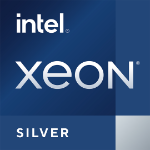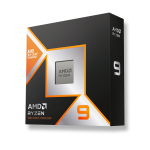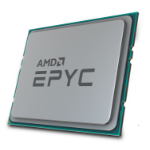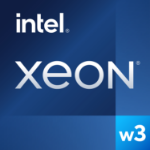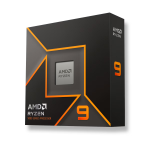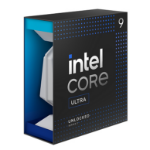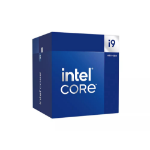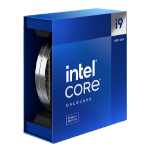Intel Core i9-10900X processor 3.7 GHz 19.25 MB Smart Cache
£602.44
£502.03
Intel® Core™ i9-10900X X-series Processor (19.25M Cache, 3.70 GHz)
More Information
| Processor socket | LGA 2066 (Socket R4) |
|---|---|
| Box | No |
| Processor cores | 10 |
| Processor family | Intel Core i9 X-series |
| SKU | CD8069504382100 |
| EAN | 8592978278403 |
| Manufacturer | Intel |
| Availability | Y |
Description
Intel® Virtualization Technology for Directed I/O (VT-d)
Intel® Virtualization Technology for Directed I/O (VT-d) continues from the existing support for IA-32 (VT-x) and Itanium® processor (VT-i) virtualization adding new support for I/O-device virtualization. Intel VT-d can help end users improve security and reliability of the systems and also improve performance of I/O devices in virtualized environments.
Intel® Virtualization Technology (VT-x)
Intel® Virtualization Technology (VT-x) allows one hardware platform to function as multiple “virtual” platforms. It offers improved manageability by limiting downtime and maintaining productivity by isolating computing activities into separate partitions.
Intel® 64
Intel® 64 architecture delivers 64-bit computing on server, workstation, desktop and mobile platforms when combined with supporting software.¹ Intel 64 architecture improves performance by allowing systems to address more than 4 GB of both virtual and physical memory.
Cache
CPU Cache is an area of fast memory located on the processor. Intel® Smart Cache refers to the architecture that allows all cores to dynamically share access to the last level cache.
Intel® AES New Instructions
Intel® AES New Instructions (Intel® AES-NI) are a set of instructions that enable fast and secure data encryption and decryption. AES-NI are valuable for a wide range of cryptographic applications, for example: applications that perform bulk encryption/decryption, authentication, random number generation, and authenticated encryption.
Intel® Turbo Boost Technology
Intel® Turbo Boost Technology dynamically increases the processor's frequency as needed by taking advantage of thermal and power headroom to give you a burst of speed when you need it, and increased energy efficiency when you don’t.
Max Turbo Frequency
Max Turbo Frequency is the maximum single-core frequency at which the processor is capable of operating using Intel® Turbo Boost Technology and, if present, Intel® Turbo Boost Max Technology 3.0 and Intel® Thermal Velocity Boost. Frequency is typically measured in gigahertz (GHz), or billion cycles per second.
Execute Disable Bit
Execute Disable Bit is a hardware-based security feature that can reduce exposure to viruses and malicious-code attacks and prevent harmful software from executing and propagating on the server or network.
Intel® Hyper-Threading Technology
Intel® Hyper-Threading Technology (Intel® HT Technology) delivers two processing threads per physical core. Highly threaded applications can get more work done in parallel, completing tasks sooner.
Intel® Optane™ Memory Supported
Intel® Optane™ memory is a revolutionary new class of non-volatile memory that sits in between system memory and storage to accelerate system performance and responsiveness. When combined with the Intel® Rapid Storage Technology Driver, it seamlessly manages multiple tiers of storage while presenting one virtual drive to the OS, ensuring that data frequently used resides on the fastest tier of storage. Intel® Optane™ memory requires specific hardware and software configuration.
Enhanced Intel SpeedStep® Technology
Enhanced Intel SpeedStep® Technology is an advanced means of enabling high performance while meeting the power-conservation needs of mobile systems. Conventional Intel SpeedStep® Technology switches both voltage and frequency in tandem between high and low levels in response to processor load. Enhanced Intel SpeedStep® Technology builds upon that architecture using design strategies such as Separation between Voltage and Frequency Changes, and Clock Partitioning and Recovery.
Intel® Deep Learning Boost (Intel® DL Boost) on CPU
A new set of embedded processor technologies designed to accelerate AI deep learning use cases. It extends Intel AVX-512 with a new Vector Neural Network Instruction (VNNI) that significantly increases deep learning inference performance over previous generations.
Instruction Set Extensions
Instruction Set Extensions are additional instructions which can increase performance when the same operations are performed on multiple data objects. These can include SSE (Streaming SIMD Extensions) and AVX (Advanced Vector Extensions).
Intel® Turbo Boost Max Technology 3.0 Frequency
Intel® Turbo Boost Max Technology 3.0 identifies the best performing core(s) on a processor and provides increased performance on those cores through increasing frequency as needed by taking advantage of power and thermal headroom. Intel® Turbo Boost Max Technology 3.0 frequency is the clock frequency of the CPU when running in this mode.
Intel® Turbo Boost Max Technology 3.0
Intel® Turbo Boost Max Technology 3.0 identifies the best performing core(s) on a processor and provides increased performance on those cores through increasing frequency as needed by taking advantage of power and thermal headroom.
# of AVX-512 FMA Units
Intel® Advanced Vector Extensions 512 (AVX-512), new instruction set extensions, delivering ultra-wide (512-bit) vector operations capabilities, with up to 2 FMAs (Fused Multiply Add instructions), to accelerate performance for your most demanding computational tasks.
Intel® Virtualization Technology for Directed I/O (VT-d) continues from the existing support for IA-32 (VT-x) and Itanium® processor (VT-i) virtualization adding new support for I/O-device virtualization. Intel VT-d can help end users improve security and reliability of the systems and also improve performance of I/O devices in virtualized environments.
Intel® Virtualization Technology (VT-x)
Intel® Virtualization Technology (VT-x) allows one hardware platform to function as multiple “virtual” platforms. It offers improved manageability by limiting downtime and maintaining productivity by isolating computing activities into separate partitions.
Intel® 64
Intel® 64 architecture delivers 64-bit computing on server, workstation, desktop and mobile platforms when combined with supporting software.¹ Intel 64 architecture improves performance by allowing systems to address more than 4 GB of both virtual and physical memory.
Cache
CPU Cache is an area of fast memory located on the processor. Intel® Smart Cache refers to the architecture that allows all cores to dynamically share access to the last level cache.
Intel® AES New Instructions
Intel® AES New Instructions (Intel® AES-NI) are a set of instructions that enable fast and secure data encryption and decryption. AES-NI are valuable for a wide range of cryptographic applications, for example: applications that perform bulk encryption/decryption, authentication, random number generation, and authenticated encryption.
Intel® Turbo Boost Technology
Intel® Turbo Boost Technology dynamically increases the processor's frequency as needed by taking advantage of thermal and power headroom to give you a burst of speed when you need it, and increased energy efficiency when you don’t.
Max Turbo Frequency
Max Turbo Frequency is the maximum single-core frequency at which the processor is capable of operating using Intel® Turbo Boost Technology and, if present, Intel® Turbo Boost Max Technology 3.0 and Intel® Thermal Velocity Boost. Frequency is typically measured in gigahertz (GHz), or billion cycles per second.
Execute Disable Bit
Execute Disable Bit is a hardware-based security feature that can reduce exposure to viruses and malicious-code attacks and prevent harmful software from executing and propagating on the server or network.
Intel® Hyper-Threading Technology
Intel® Hyper-Threading Technology (Intel® HT Technology) delivers two processing threads per physical core. Highly threaded applications can get more work done in parallel, completing tasks sooner.
Intel® Optane™ Memory Supported
Intel® Optane™ memory is a revolutionary new class of non-volatile memory that sits in between system memory and storage to accelerate system performance and responsiveness. When combined with the Intel® Rapid Storage Technology Driver, it seamlessly manages multiple tiers of storage while presenting one virtual drive to the OS, ensuring that data frequently used resides on the fastest tier of storage. Intel® Optane™ memory requires specific hardware and software configuration.
Enhanced Intel SpeedStep® Technology
Enhanced Intel SpeedStep® Technology is an advanced means of enabling high performance while meeting the power-conservation needs of mobile systems. Conventional Intel SpeedStep® Technology switches both voltage and frequency in tandem between high and low levels in response to processor load. Enhanced Intel SpeedStep® Technology builds upon that architecture using design strategies such as Separation between Voltage and Frequency Changes, and Clock Partitioning and Recovery.
Intel® Deep Learning Boost (Intel® DL Boost) on CPU
A new set of embedded processor technologies designed to accelerate AI deep learning use cases. It extends Intel AVX-512 with a new Vector Neural Network Instruction (VNNI) that significantly increases deep learning inference performance over previous generations.
Instruction Set Extensions
Instruction Set Extensions are additional instructions which can increase performance when the same operations are performed on multiple data objects. These can include SSE (Streaming SIMD Extensions) and AVX (Advanced Vector Extensions).
Intel® Turbo Boost Max Technology 3.0 Frequency
Intel® Turbo Boost Max Technology 3.0 identifies the best performing core(s) on a processor and provides increased performance on those cores through increasing frequency as needed by taking advantage of power and thermal headroom. Intel® Turbo Boost Max Technology 3.0 frequency is the clock frequency of the CPU when running in this mode.
Intel® Turbo Boost Max Technology 3.0
Intel® Turbo Boost Max Technology 3.0 identifies the best performing core(s) on a processor and provides increased performance on those cores through increasing frequency as needed by taking advantage of power and thermal headroom.
# of AVX-512 FMA Units
Intel® Advanced Vector Extensions 512 (AVX-512), new instruction set extensions, delivering ultra-wide (512-bit) vector operations capabilities, with up to 2 FMAs (Fused Multiply Add instructions), to accelerate performance for your most demanding computational tasks.
Specifications
| Processor | |
|---|---|
| Processor generation | 10th gen Intel® Core™ i9 |
| Processor base frequency | 3.7 GHz |
| Processor manufacturer | Intel |
| Cooler included | No |
| Processor codename | Cascade Lake |
| Memory bandwidth supported by processor (max) | 94 GB/s |
| Thermal Design Power (TDP) | 165 W |
| Processor cache | 19.25 MB |
| Processor ARK ID | 198019 |
| Processor model | i9-10900X |
| Processor threads | 20 |
| System bus rate | 8 GT/s |
| Processor operating modes | 64-bit |
| Processor boost frequency | 4.5 GHz |
| Component for | PC |
| Processor lithography | 14 nm |
| Processor family | Intel® Core™ i9 X-series |
| Processor cores | 10 |
| Box | No |
| Processor socket | LGA 2066 (Socket R4) |
| Processor cache type | Smart Cache |
| Generation | 10th Generation |
| Memory | |
| Maximum internal memory supported by processor | 256 GB |
| Memory types supported by processor | DDR4-SDRAM |
| Memory clock speeds supported by processor | 2933 MHz |
| Memory bandwidth supported by processor (max) | 94 GB/s |
| Supported memory types | DDR4-SDRAM |
| Memory channels | Quad-channel |
| ECC | No |
| Graphics | |
| Discrete graphics card | No |
| On-board graphics card model | Not available |
| On-board graphics card | No |
| Discrete graphics card model | Not available |
| Power | |
| Thermal Design Power (TDP) | 165 W |
| Technical details | |
| Thermal solution specification | PCG 2017X |
| Intel® Turbo Boost Technology | 2.0 |
| Intel® Hyper Threading Technology (Intel® HT Technology) | Yes |
| Intel® AES New Instructions (Intel® AES-NI) | Yes |
| Execute Disable Bit | Yes |
| Enhanced Intel SpeedStep Technology | Yes |
| PCI Express slots version | 3.0 |
| Supported instruction sets | SSE4.1, SSE4.2, AVX 2.0, AVX-512 |
| Scalability | 1S |
| Embedded options available | No |
| CPU configuration (max) | 1 |
| Product type | Processor |
| Intel Virtualization Technology for Directed I/O (VT-d) | Yes |
| Intel 64 | Yes |
| Thermal Design Power (TDP) | 165 W |
| Supported memory types | DDR4-SDRAM |
| Status | Launched |
| Market segment | Desktop |
| Launch date | Q4'19 |
| Intel Virtualization Technology (VT-x) | Yes |
| Processor cache type | Smart Cache |
| Maximum memory | 256 GB |
| AVX-512 Fused Multiply-Add (FMA) units | 2 |
| Bus speed | 8 GT/s DMI3 |
| Target market | Gaming, Content Creation |
| Features | |
|---|---|
| Maximum number of PCI Express lanes | 48 |
| Thermal Design Power (TDP) | 165 W |
| Processor ARK ID | 198019 |
| Thermal solution specification | PCG 2017X |
| Execute Disable Bit | Yes |
| PCI Express slots version | 3.0 |
| Supported instruction sets | SSE4.1, SSE4.2, AVX 2.0, AVX-512 |
| Scalability | 1S |
| Embedded options available | No |
| CPU configuration (max) | 1 |
| Market segment | Desktop |
| Harmonized System (HS) code | 85423119 |
| Export Control Classification Number (ECCN) | 5A992C |
| Commodity Classification Automated Tracking System (CCATS) | G077159 |
| PCI Express CEM revision | 3.0 |
| Processor special features | |
| Intel Virtualization Technology for Directed I/O (VT-d) | Yes |
| Intel 64 | Yes |
| Intel Turbo Boost Max Technology 3.0 | Yes |
| Intel® Optane™ Memory Ready | Yes |
| Intel® Turbo Boost Technology | 2.0 |
| Intel® Hyper Threading Technology (Intel® HT Technology) | Yes |
| Intel® AES New Instructions (Intel® AES-NI) | Yes |
| Enhanced Intel SpeedStep Technology | Yes |
| Intel Virtualization Technology (VT-x) | Yes |
| AVX-512 Fused Multiply-Add (FMA) units | 2 |
| Intel® Deep Learning Boost (Intel® DL Boost) on CPU | Yes |
| Intel® Turbo Boost Max Technology 3.0 frequency | 4.7 GHz |
| Operational conditions | |
| Tjunction | 94 °C |
| Packaging data | |
| Package type | Retail box |
| Logistics data | |
| Harmonized System (HS) code | 85423119 |
| Other features | |
| Maximum internal memory | 256 GB |
| CPU configuration (max) | 1 |
Delivery Details
- UK distributors.
- Order before 4 pm for next-day delivery.
- Standard (2-3 days) £7.50
- Next Day £9.99
- Free standard delivery over £100
There are deivery surcharges to these postcodes:
| Postcode | Charge |
| IV3-40 | £20 |
| IV52-54 | £20 |
| IV63 | £20 |
| KW1-14 | £20 |
| PA10-40 | £20 |
| PH19-40 | £20 |
| PH50 | £20 |
| HS | £50 |
| IV41-51 | £50 |
| IV55-56 | £50 |
| KA27-28 | £50 |
| KW15-17 | £50 |
| PA41-49 | £50 |
| PA60-62 | £50 |
| PA76-78 | £50 |
| PH41-44 | £50 |
| ZE | £50 |
| IM | £50 |
| JE | £50 |
| GY | £50 |
| TR21-25 | £50 |
| BT | £20 |
Suggested Products
AMD EPYC 9124 processor 3 GHz 64 MB L3
Shop NowIntel Xeon Silver 4510 processor 2.4 GHz 30 MB
Shop NowAMD Ryzen 9 9950X3D processor 4.3 GHz 144 MB L2 & ...
Shop NowAMD EPYC 4584PX processor 4.2 GHz 128 MB L3
Shop NowAMD Ryzen 9 7900X processor 4.7 GHz 64 MB L3
Shop NowAMD Ryzen 9 9900X3D processor 4.4 GHz 140 MB L2 & ...
Shop NowIntel Xeon E-2386G processor 3.5 GHz 12 MB Smart C...
Shop NowAMD Ryzen 9 9950X3D processor 4.3 GHz 144 MB L2 & ...
Shop NowAMD Ryzen 9 9900X3D processor 4.4 GHz 140 MB L2 & ...
Shop NowAMD EPYC 7313 processor 3 GHz 128 MB L3
Shop NowAMD Ryzen 9 9950X processor 4.3 GHz 80 MB L2 & L3 ...
Shop NowIntel Core Ultra 9 285 processor 36 MB Smart Cache...
Shop NowIntel Core i9-14900 processor 36 MB Smart Cache Bo...
Shop NowIntel Core i9-14900KS processor 36 MB Smart Cache ...
Shop NowIntel Core Ultra 9 285K processor 36 MB Smart Cach...
Shop NowYou may also be interested in
| Product |
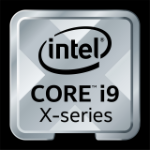
Recommended
Intel Core i9-10900X processor 3.7 GHz...
£602.44
£502.03
|

New
AMD EPYC 7313 processor 3 GHz 128 MB L3
£499.01
£415.84
|
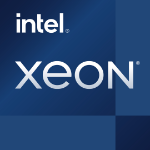 Intel Xeon E-2386G processor 3.5 GHz 1...
Intel Xeon E-2386G processor 3.5 GHz 1...
£555.89
£463.24
|

Popular
Intel Xeon E-2388G processor 3.2 GHz 1...
£689.86
£574.88
|
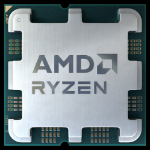
Bestseller
AMD Ryzen 9 7900X processor 4.7 GHz 64...
£528.61
£440.51
|

Hot Product
AMD EPYC 9124 processor 3 GHz 64 MB L3
£839.62
£699.68
|
|---|---|---|---|---|---|---|
| SKU |
CD8069504382100
|
100-000000329
|
CM8070804494716
|
CM8070804494617
|
100-000000589
|
100-000000802
|
| Description |
Intel® Virtualization Technology for Directed I/O (VT-d)
Intel® Virtualization Technology for Directed I/O (VT-d) continues from the existing support for IA-32 (VT-x) and Itanium® processor (VT-i) virtualization adding new support for I/O-device virtualization. Intel VT-d can help end users improve security and reliability of the systems and also improve performance of I/O devices in virtualized environments. Intel® Virtualization Technology (VT-x) Intel® Virtualization Technology (VT-x) allows one hardware platform to function as multiple “virtual” platforms. It offers improved manageability by limiting downtime and maintaining productivity by isolating computing activities into separate partitions. Intel® 64 Intel® 64 architecture delivers 64-bit computing on server, workstation, desktop and mobile platforms when combined with supporting software.¹ Intel 64 architecture improves performance by allowing systems to address more than 4 GB of both virtual and physical memory. Cache CPU Cache is an area of fast memory located on the processor. Intel® Smart Cache refers to the architecture that allows all cores to dynamically share access to the last level cache. Intel® AES New Instructions Intel® AES New Instructions (Intel® AES-NI) are a set of instructions that enable fast and secure data encryption and decryption. AES-NI are valuable for a wide range of cryptographic applications, for example: applications that perform bulk encryption/decryption, authentication, random number generation, and authenticated encryption. Intel® Turbo Boost Technology Intel® Turbo Boost Technology dynamically increases the processor's frequency as needed by taking advantage of thermal and power headroom to give you a burst of speed when you need it, and increased energy efficiency when you don’t. Max Turbo Frequency Max Turbo Frequency is the maximum single-core frequency at which the processor is capable of operating using Intel® Turbo Boost Technology and, if present, Intel® Turbo Boost Max Technology 3.0 and Intel® Thermal Velocity Boost. Frequency is typically measured in gigahertz (GHz), or billion cycles per second. Execute Disable Bit Execute Disable Bit is a hardware-based security feature that can reduce exposure to viruses and malicious-code attacks and prevent harmful software from executing and propagating on the server or network. Intel® Hyper-Threading Technology Intel® Hyper-Threading Technology (Intel® HT Technology) delivers two processing threads per physical core. Highly threaded applications can get more work done in parallel, completing tasks sooner. Intel® Optane™ Memory Supported Intel® Optane™ memory is a revolutionary new class of non-volatile memory that sits in between system memory and storage to accelerate system performance and responsiveness. When combined with the Intel® Rapid Storage Technology Driver, it seamlessly manages multiple tiers of storage while presenting one virtual drive to the OS, ensuring that data frequently used resides on the fastest tier of storage. Intel® Optane™ memory requires specific hardware and software configuration. Enhanced Intel SpeedStep® Technology Enhanced Intel SpeedStep® Technology is an advanced means of enabling high performance while meeting the power-conservation needs of mobile systems. Conventional Intel SpeedStep® Technology switches both voltage and frequency in tandem between high and low levels in response to processor load. Enhanced Intel SpeedStep® Technology builds upon that architecture using design strategies such as Separation between Voltage and Frequency Changes, and Clock Partitioning and Recovery. Intel® Deep Learning Boost (Intel® DL Boost) on CPU A new set of embedded processor technologies designed to accelerate AI deep learning use cases. It extends Intel AVX-512 with a new Vector Neural Network Instruction (VNNI) that significantly increases deep learning inference performance over previous generations. Instruction Set Extensions Instruction Set Extensions are additional instructions which can increase performance when the same operations are performed on multiple data objects. These can include SSE (Streaming SIMD Extensions) and AVX (Advanced Vector Extensions). Intel® Turbo Boost Max Technology 3.0 Frequency Intel® Turbo Boost Max Technology 3.0 identifies the best performing core(s) on a processor and provides increased performance on those cores through increasing frequency as needed by taking advantage of power and thermal headroom. Intel® Turbo Boost Max Technology 3.0 frequency is the clock frequency of the CPU when running in this mode. Intel® Turbo Boost Max Technology 3.0 Intel® Turbo Boost Max Technology 3.0 identifies the best performing core(s) on a processor and provides increased performance on those cores through increasing frequency as needed by taking advantage of power and thermal headroom. # of AVX-512 FMA Units Intel® Advanced Vector Extensions 512 (AVX-512), new instruction set extensions, delivering ultra-wide (512-bit) vector operations capabilities, with up to 2 FMAs (Fused Multiply Add instructions), to accelerate performance for your most demanding computational tasks. |
Accelerate Workload Performance
Data centers that require the best CPU performance, security features, and scalability count on Solution Briefs and White Papers Find the technical resources you need to learn more about AMD EPYC™. Where to Buy EPYC™️ Powered Solutions Find a partner offering AMD EPYC™ Processors and solutions. AMD Data Center Insights and Updates Sign up to receive the latest data center news and server content. AMD Infinity Guard Help minimize potential attack surfaces as software is booted, executed, and processes your critical data AMD Infinity Architecture With architecture, performance, and security leadership, our approach to processor design accelerates the pace of innovation so that you can break through years of data center stagnation. |
Intel® Trusted Execution Technology
Intel® Trusted Execution Technology for safer computing is a versatile set of hardware extensions to Intel® processors and chipsets that enhance the digital office platform with security capabilities such as measured launch and protected execution. It enables an environment where applications can run within their own space, protected from all other software on the system. Intel® Virtualization Technology for Directed I/O (VT-d) Intel® Virtualization Technology for Directed I/O (VT-d) continues from the existing support for IA-32 (VT-x) and Itanium® processor (VT-i) virtualization adding new support for I/O-device virtualization. Intel VT-d can help end users improve security and reliability of the systems and also improve performance of I/O devices in virtualized environments. Intel® Virtualization Technology (VT-x) Intel® Virtualization Technology (VT-x) allows one hardware platform to function as multiple “virtual” platforms. It offers improved manageability by limiting downtime and maintaining productivity by isolating computing activities into separate partitions. Intel® 64 Intel® 64 architecture delivers 64-bit computing on server, workstation, desktop and mobile platforms when combined with supporting software.¹ Intel 64 architecture improves performance by allowing systems to address more than 4 GB of both virtual and physical memory. Intel® Clear Video HD Technology Intel® Clear Video HD Technology, like its predecessor, Intel® Clear Video Technology, is a suite of image decode and processing technologies built into the integrated processor graphics that improve video playback, delivering cleaner, sharper images, more natural, accurate, and vivid colors, and a clear and stable video picture. Intel® Clear Video HD Technology adds video quality enhancements for richer color and more realistic skin tones. Cache CPU Cache is an area of fast memory located on the processor. Intel® Smart Cache refers to the architecture that allows all cores to dynamically share access to the last level cache. Intel® AES New Instructions Intel® AES New Instructions (Intel® AES-NI) are a set of instructions that enable fast and secure data encryption and decryption. AES-NI are valuable for a wide range of cryptographic applications, for example: applications that perform bulk encryption/decryption, authentication, random number generation, and authenticated encryption. Intel® InTru™ 3D Technology Intel® InTru™ 3D Technology provides stereoscopic 3-D Blu-ray* playback in full 1080p resolution over HDMI* 1.4 and premium audio. Idle States Idle States (C-states) are used to save power when the processor is idle. C0 is the operational state, meaning that the CPU is doing useful work. C1 is the first idle state, C2 the second, and so on, where more power saving actions are taken for numerically higher C-states. Intel® Turbo Boost Technology Intel® Turbo Boost Technology dynamically increases the processor's frequency as needed by taking advantage of thermal and power headroom to give you a burst of speed when you need it, and increased energy efficiency when you don’t. Max Turbo Frequency Max Turbo Frequency is the maximum single-core frequency at which the processor is capable of operating using Intel® Turbo Boost Technology and, if present, Intel® Turbo Boost Max Technology 3.0 and Intel® Thermal Velocity Boost. Frequency is typically measured in gigahertz (GHz), or billion cycles per second. Execute Disable Bit Execute Disable Bit is a hardware-based security feature that can reduce exposure to viruses and malicious-code attacks and prevent harmful software from executing and propagating on the server or network. Intel® Hyper-Threading Technology Intel® Hyper-Threading Technology (Intel® HT Technology) delivers two processing threads per physical core. Highly threaded applications can get more work done in parallel, completing tasks sooner. Instruction Set An instruction set refers to the basic set of commands and instructions that a microprocessor understands and can carry out. The value shown represents which Intel’s instruction set this processor is compatible with. Intel® Quick Sync Video Intel® Quick Sync Video delivers fast conversion of video for portable media players, online sharing, and video editing and authoring. Intel vPro® Platform Eligibility The Intel vPro® platform is a set of hardware and technologies used to build business computing endpoints with premium performance, built-in security, modern manageability and platform stability. Intel® VT-x with Extended Page Tables (EPT) Intel® VT-x with Extended Page Tables (EPT), also known as Second Level Address Translation (SLAT), provides acceleration for memory intensive virtualized applications. Extended Page Tables in Intel® Virtualization Technology platforms reduces the memory and power overhead costs and increases battery life through hardware optimization of page table management. Enhanced Intel SpeedStep® Technology Enhanced Intel SpeedStep® Technology is an advanced means of enabling high performance while meeting the power-conservation needs of mobile systems. Conventional Intel SpeedStep® Technology switches both voltage and frequency in tandem between high and low levels in response to processor load. Enhanced Intel SpeedStep® Technology builds upon that architecture using design strategies such as Separation between Voltage and Frequency Changes, and Clock Partitioning and Recovery. Intel® Clear Video Technology Intel® Clear Video Technology is a suite of image decode and processing technologies built into the integrated processor graphics that improve video playback, delivering cleaner, sharper images, more natural, accurate, and vivid colors, and a clear and stable video picture. Secure Key Intel® Secure Key consists of a digital random number generator that creates truly random numbers to strengthen encryption algorithms. Intel® Turbo Boost Technology 2.0 Frequency Intel® Turbo Boost Technology 2.0 Frequency is the maximum single core frequency at which the processor is capable of operating using Intel® Turbo Boost Technology. Frequency is typically measured in gigahertz (GHz), or billion cycles per second. Intel® Software Guard Extensions (Intel® SGX) Intel® Software Guard Extensions (Intel® SGX) provide applications the ability to create hardware enforced trusted execution protection for their applications’ sensitive routines and data. Intel® SGX provides developers a way to partition their code and data into CPU hardened trusted execution environments (TEE’s). Instruction Set Extensions Instruction Set Extensions are additional instructions which can increase performance when the same operations are performed on multiple data objects. These can include SSE (Streaming SIMD Extensions) and AVX (Advanced Vector Extensions). Thermal Monitoring Technologies Thermal Monitoring Technologies protect the processor package and the system from thermal failure through several thermal management features. An on-die Digital Thermal Sensor (DTS) detects the core's temperature, and the thermal management features reduce package power consumption and thereby temperature when required in order to remain within normal operating limits. Intel® Optane™ Persistent Memory Supported Intel® Optane™ persistent memory is a revolutionary tier of non-volatile memory that sits between memory and storage to provide large, affordable memory capacity that is comparable to DRAM performance. Delivering large system-level memory capacity when combined with traditional DRAM, Intel Optane persistent memory is helping transform critical memory constrained workloads – from cloud, databases, in-memory analytics, virtualization, and content delivery networks. Intel® Memory Protection Extensions (Intel® MPX) Intel® Memory Protection Extensions (Intel® MPX) provides a set of hardware features that can be used by software in conjunction with compiler changes to check that memory references intended at compile time do not become unsafe at runtime due to buffer overflow or underflow. Intel® Boot Guard Intel® Device Protection Technology with Boot Guard helps protect the system’s pre-OS environment from viruses and malicious software attacks. Intel® Transactional Synchronization Extensions Intel® Transactional Synchronization Extensions (Intel® TSX) are a set of instructions that add hardware transactional memory support to improve performance of multi-threaded software. |
Intel® Trusted Execution Technology
Intel® Trusted Execution Technology for safer computing is a versatile set of hardware extensions to Intel® processors and chipsets that enhance the digital office platform with security capabilities such as measured launch and protected execution. It enables an environment where applications can run within their own space, protected from all other software on the system. Intel® Virtualization Technology for Directed I/O (VT-d) Intel® Virtualization Technology for Directed I/O (VT-d) continues from the existing support for IA-32 (VT-x) and Itanium® processor (VT-i) virtualization adding new support for I/O-device virtualization. Intel VT-d can help end users improve security and reliability of the systems and also improve performance of I/O devices in virtualized environments. Intel® Virtualization Technology (VT-x) Intel® Virtualization Technology (VT-x) allows one hardware platform to function as multiple “virtual” platforms. It offers improved manageability by limiting downtime and maintaining productivity by isolating computing activities into separate partitions. Intel® 64 Intel® 64 architecture delivers 64-bit computing on server, workstation, desktop and mobile platforms when combined with supporting software.¹ Intel 64 architecture improves performance by allowing systems to address more than 4 GB of both virtual and physical memory. Intel® Clear Video HD Technology Intel® Clear Video HD Technology, like its predecessor, Intel® Clear Video Technology, is a suite of image decode and processing technologies built into the integrated processor graphics that improve video playback, delivering cleaner, sharper images, more natural, accurate, and vivid colors, and a clear and stable video picture. Intel® Clear Video HD Technology adds video quality enhancements for richer color and more realistic skin tones. Cache CPU Cache is an area of fast memory located on the processor. Intel® Smart Cache refers to the architecture that allows all cores to dynamically share access to the last level cache. Intel® AES New Instructions Intel® AES New Instructions (Intel® AES-NI) are a set of instructions that enable fast and secure data encryption and decryption. AES-NI are valuable for a wide range of cryptographic applications, for example: applications that perform bulk encryption/decryption, authentication, random number generation, and authenticated encryption. Intel® InTru™ 3D Technology Intel® InTru™ 3D Technology provides stereoscopic 3-D Blu-ray* playback in full 1080p resolution over HDMI* 1.4 and premium audio. Idle States Idle States (C-states) are used to save power when the processor is idle. C0 is the operational state, meaning that the CPU is doing useful work. C1 is the first idle state, C2 the second, and so on, where more power saving actions are taken for numerically higher C-states. Intel® Turbo Boost Technology Intel® Turbo Boost Technology dynamically increases the processor's frequency as needed by taking advantage of thermal and power headroom to give you a burst of speed when you need it, and increased energy efficiency when you don’t. Max Turbo Frequency Max Turbo Frequency is the maximum single-core frequency at which the processor is capable of operating using Intel® Turbo Boost Technology and, if present, Intel® Turbo Boost Max Technology 3.0 and Intel® Thermal Velocity Boost. Frequency is typically measured in gigahertz (GHz), or billion cycles per second. Execute Disable Bit Execute Disable Bit is a hardware-based security feature that can reduce exposure to viruses and malicious-code attacks and prevent harmful software from executing and propagating on the server or network. Intel® Hyper-Threading Technology Intel® Hyper-Threading Technology (Intel® HT Technology) delivers two processing threads per physical core. Highly threaded applications can get more work done in parallel, completing tasks sooner. Instruction Set An instruction set refers to the basic set of commands and instructions that a microprocessor understands and can carry out. The value shown represents which Intel’s instruction set this processor is compatible with. Intel® Quick Sync Video Intel® Quick Sync Video delivers fast conversion of video for portable media players, online sharing, and video editing and authoring. Intel vPro® Platform Eligibility The Intel vPro® platform is a set of hardware and technologies used to build business computing endpoints with premium performance, built-in security, modern manageability and platform stability. Intel® VT-x with Extended Page Tables (EPT) Intel® VT-x with Extended Page Tables (EPT), also known as Second Level Address Translation (SLAT), provides acceleration for memory intensive virtualized applications. Extended Page Tables in Intel® Virtualization Technology platforms reduces the memory and power overhead costs and increases battery life through hardware optimization of page table management. Enhanced Intel SpeedStep® Technology Enhanced Intel SpeedStep® Technology is an advanced means of enabling high performance while meeting the power-conservation needs of mobile systems. Conventional Intel SpeedStep® Technology switches both voltage and frequency in tandem between high and low levels in response to processor load. Enhanced Intel SpeedStep® Technology builds upon that architecture using design strategies such as Separation between Voltage and Frequency Changes, and Clock Partitioning and Recovery. Intel® Clear Video Technology Intel® Clear Video Technology is a suite of image decode and processing technologies built into the integrated processor graphics that improve video playback, delivering cleaner, sharper images, more natural, accurate, and vivid colors, and a clear and stable video picture. Secure Key Intel® Secure Key consists of a digital random number generator that creates truly random numbers to strengthen encryption algorithms. Intel® Turbo Boost Technology 2.0 Frequency Intel® Turbo Boost Technology 2.0 Frequency is the maximum single core frequency at which the processor is capable of operating using Intel® Turbo Boost Technology. Frequency is typically measured in gigahertz (GHz), or billion cycles per second. Intel® Software Guard Extensions (Intel® SGX) Intel® Software Guard Extensions (Intel® SGX) provide applications the ability to create hardware enforced trusted execution protection for their applications’ sensitive routines and data. Intel® SGX provides developers a way to partition their code and data into CPU hardened trusted execution environments (TEE’s). Instruction Set Extensions Instruction Set Extensions are additional instructions which can increase performance when the same operations are performed on multiple data objects. These can include SSE (Streaming SIMD Extensions) and AVX (Advanced Vector Extensions). Thermal Monitoring Technologies Thermal Monitoring Technologies protect the processor package and the system from thermal failure through several thermal management features. An on-die Digital Thermal Sensor (DTS) detects the core's temperature, and the thermal management features reduce package power consumption and thereby temperature when required in order to remain within normal operating limits. Intel® Optane™ Persistent Memory Supported Intel® Optane™ persistent memory is a revolutionary tier of non-volatile memory that sits between memory and storage to provide large, affordable memory capacity that is comparable to DRAM performance. Delivering large system-level memory capacity when combined with traditional DRAM, Intel Optane persistent memory is helping transform critical memory constrained workloads – from cloud, databases, in-memory analytics, virtualization, and content delivery networks. Intel® Memory Protection Extensions (Intel® MPX) Intel® Memory Protection Extensions (Intel® MPX) provides a set of hardware features that can be used by software in conjunction with compiler changes to check that memory references intended at compile time do not become unsafe at runtime due to buffer overflow or underflow. Intel® Boot Guard Intel® Device Protection Technology with Boot Guard helps protect the system’s pre-OS environment from viruses and malicious software attacks. Intel® Transactional Synchronization Extensions Intel® Transactional Synchronization Extensions (Intel® TSX) are a set of instructions that add hardware transactional memory support to improve performance of multi-threaded software. |
The Powerful Gaming and Streaming Desktop Processor
Get the competitive edge with the ultimate enthusiast processor for gamers, for creators, for everyone. |
Powering Modern Data Centers
Realize exceptional time-to-results and energy efficiency for your business-critical applications with AMD. AMD Infinity Guard Help minimize potential attack surfaces as software is booted, executed, and processes your critical data AMD Infinity Architecture Experience unified intelligence. |
| Short Description |
Intel® Core™ i9-10900X X-series Processor (19.25M Cache, 3.70 GHz)
|
16 cores, 32 threads, 3GHz base clock, 3.7GHz boost clock, 128MB L3 cache, 155W TDP
|
Intel Xeon E2386G Processor 12M Cache 3.50 GHz
|
Intel Xeon E2388G Processor 16M Cache 3.20 GHz
|
Socket AM5, 12 cores, 24 threads, 4.7 GHz base clock, 5.6 GHz boost clock, 64 MB L3 cache
|
3.0 GHz, 16 CPU Core, L3 64 MB, SP5, TDP 200W
|
| Manufacturer |
Intel
|
AMD
|
Intel
|
Intel
|
AMD
|
AMD
|




